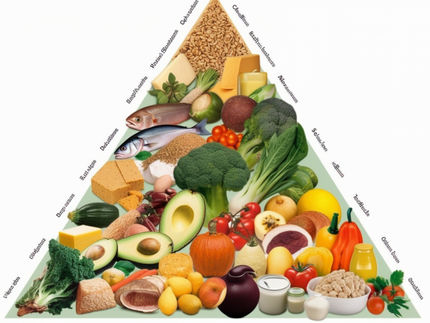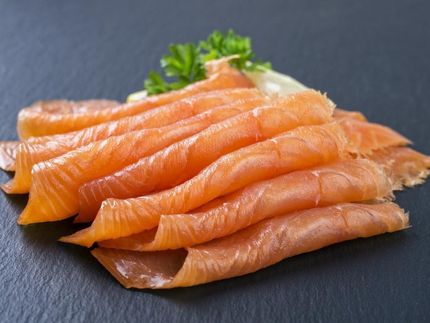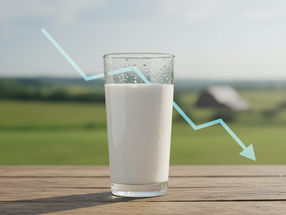Food pyramid is influenced by politics, the economy and society
Advertisement
In Germany, Austria and Switzerland there are new recommendations for a healthy diet. Behind these food pyramids there is often more business and society than nutritionists.

The first food pyramid was published in 1992 by the US Department of Agriculture (USDA). (USDA)
USDA

In 2011, the "MyPlate" recommendations in the form of a plate replaced the previous food pyramid of the US Department of Agriculture.
USDA

Harvard University in Boston, USA, presented the so-called "Healthy Eating Plate" in 2017.
Harvard Universität

The new Swiss food pyramid takes the impact on the environment into account for the first time.
BLV

The new food pyramid 2024 from the German Nutrition Society
DGE/BLE





The government recommendations for a healthy diet have been criticized ever since they have existed. The history of these food pyramids is less a history of nutritional science than a history of lobbying by politicians, business interests and environmental organizations.
The first food pyramid and the ongoing criticism
The first food pyramid was published by the US Department of Agriculture (USDA) in 1992. Despite criticism, many other countries adopted it.
The USDA pyramid from 1992 looks like this:
Grain products made from refined grains: 45 percent (white bread, rice and pasta)
Vegetables and fruit: 15 percent each
Animal and vegetable proteins: 10 percent (red meat, poultry and fish, eggs, pulses and nuts)
Milk and dairy products: 10 percent
Fats, oils and sweets: 5 percent
The USDA pyramid recommends a diet with a maximum of 20 to 25 percent animal proteins. With the exception of the "Healthy Eating Plate" with 15 to 20 percent, this percentage has been maintained by all subsequent models to date.
The USDA pyramid is criticized because the US Department of Agriculture recommends many refined grain products to compensate for the nosedive in wheat prices at the time. The excessive consumption of "white bread" and "mac and cheese" led to an increase in obesity among the US population.
Healthy fats from olive oil, nuts and fish as well as vegetable proteins are ignored. The pyramid also makes no distinction between unprocessed and highly processed foods and does not specify portion sizes.
In 2011, the "MyPlate" plate replaced the food pyramid
Criticism of the food pyramid led the US Department of Agriculture to develop the "MyPlate" recommendations in the form of a plate in 2011:
Vegetables: 30 percent
Fruit: 20 percent percent
Grain products and potatoes: 30 percent (bread and side dishes such as rice and pasta)
Animal and plant proteins: 20 percent (red meat, poultry and fish, eggs, legumes and nuts)
Milk and dairy products: Two portions per day are counted separately
"MyPlate" also recommends a diet with a maximum of 20 to 25 percent animal proteins. Nevertheless, vegans are criticizing the recommendation for milk and dairy products for the first time.
Due to pressure from the US food industry, "MyPlate" still does not differentiate between unprocessed and highly processed foods and "MyPlate" also does not provide any information on portion sizes.
In 2017, Harvard University presented the "Healthy Eating Plate"
In order to correct the weaknesses of the USDA food pyramid and "MyPlate", Harvard University in Boston developed the "Healthy Eating Plate" in 2017. For the first time, recommendations were made for drinks such as water, tea, coffee and other unsweetened beverages.
The "Healthy Eating Plate" is made up as follows:
Vegetables: 30 percent (expressly excluding potatoes, which should be avoided due to the rapid rise in blood sugar levels)
Fruit: 20 percent
Cereal products, preferably whole grain: 30 percent (bread and side dishes such as rice and pasta)
Animal and vegetable proteins: 20 percent (fish and poultry, eggs, pulses and nuts, but little red meat or processed meat such as ham and sausage)
Milk and dairy products: Two portions per day are counted separately
Vegetable oils from olives, rapeseed, soy, corn, sunflowers and peanuts are counted separately
The "Healthy Eating Plate" recommends a diet with only 15 to 20 percent animal proteins. Nevertheless, vegans criticize the fact that dairy products are still mentioned.
The "Healthy Eating Plate" now differentiates foods according to their quality, recommending whole grain products instead of refined grains, for example. However, the "Healthy Eating Plate" does not provide any information on portion sizes either.
The new Swiss food pyramid takes into account the impact on the environment for the first time
The new Swiss food pyramid was published in mid-September 2024. This comes from the kitchen of the Federal Food Safety Office FSVO and the Swiss Society for Nutrition SGE. The SGE also provides its own plate model.
The new Swiss food pyramid also takes into account the impact on the environment for the first time. Seasonal and regional products, wholegrain products and plant-based protein sources are recommended. In addition, explicit reference is made to consuming less processed food.
The new Swiss food pyramid:
Drinks: 1 to 2 liters of water, tea and coffee and other unsweetened drinks per day
Vegetables and fruit: 25 percent and 20 percent respectively
Cereal products, preferably whole grains and potatoes: 25 percent (bread and side dishes such as rice and pasta)
Animal and vegetable proteins: 10 percent (meat and fish, eggs, pulses and products made from them)
Milk and dairy products: 20 percent and a maximum of three portions per day
A handful of nuts and seeds per day and two tablespoons of fats and vegetable oils per day
Fatty, sweet and salty foods, sweet drinks and alcohol: rarely
The new Swiss pyramid also recommends a diet with 20 to 25 percent animal proteins.
"Mixing up health and the environment only creates confusion"
However, the Swiss Farmers' Union (SBC) is very pleased. Sandra Helfenstein, head of communications at the SBV, points out glaring contradictions in the new food pyramid: "One authority criticizes feed imports for poultry, while the other promotes the consumption of chicken meat in the pyramid. This authority propagates nose to tail - i.e. from snout to tail - and the other shows a chicken breast of all things as a symbol for meat in the pyramid."
It is also a contradiction that apple juice falls out of the food pyramid because it has less dietary fiber, its glycemic load is higher and the juice does not lead to the same feeling of satiety as a whole apple. "Apple juice makes a lot of sense from an environmental point of view and for reducing food waste, and apples from high-stem trees, which are valuable for biodiversity, are often only suitable for juice production," emphasizes Sandra Helfenstein, Head of Communications at SBV. "The confusion between good for health and good for the environment only creates confusion," she complains.
Mathias Binswanger, one of Switzerland's most influential economists, takes a more relaxed view: "You shouldn't take food pyramids like this too seriously, but at most see them as a kind of recommendation." According to Mathias Binswanger, "the empirical evidence for healthy eating is very flexible and always recommends other forms of healthy eating".
In addition, the effects on the environment that are now included are heavily dependent on assumptions that have to be made with regard to environmental effects. The individual differences between people are completely disregarded. And then Mathias Binswanger says: "Eating and drinking should be enjoyable and contribute to a happy life - a life that is too healthy can also become unhealthy in the long term."
Harsh criticism of the new food pyramid in Germany
At the end of September 2024, the German Nutrition Society (DGE) and the Federal Office for Agriculture and Food (BLE) presented their revised version of the German food pyramid. This pyramid also takes into account the impact on the environment for the first time.
The new German food pyramid:
Drinks: 1.5 liters of water, tea and coffee and other unsweetened drinks per day
Vegetables and fruit: 35 percent and 15 percent respectively
Cereal products, preferably whole grains and potatoes: 30 percent (bread and side dishes such as rice and pasta)
Animal and vegetable proteins: 10 percent (meat and fish, one egg per week, pulses and products made from them)
Milk and dairy products: 15 percent and a maximum of two portions per day
A handful of nuts and seeds per day, one tablespoon of fats and vegetable oils per day
Fatty, sweet and salty foods: rarely
The new German pyramid recommends a diet with 20 to 25 percent animal proteins. The fact that Germans should therefore only consume two portions of milk or dairy products a day raised the blood pressure of milk producers to unhealthy levels: "This is scaremongering and unrealistic!"
And the recommendation to eat only 300 grams of meat per week instead of 1,000 grams and only one egg instead of five eggs caused the meat and egg producers to go on the barricades.
Even the German Academy of Preventive Medicine (DAPM) criticized the new dietary recommendations. The DAPM sees "serious errors in the approach of these recommendations and in content statements that are outdated and not evidence-based and also appear to place climate protection above the health of the population in some cases."
Austria adopts the US plate model and integrates the vegan diet
The new Austrian dietary recommendations will also be published in the coming weeks. Research shows that, as in Germany and Switzerland, the impact on the environment will now also be taken into account in Austria.
The new dietary recommendations in Austria:
Drinks: 1.5 liters of water, tea and coffee and other unsweetened drinks per day
Vegetables and fruit: 25 percent
Cereal products, preferably whole grains and potatoes: 20 percent (bread and side dishes such as rice and pasta)
Animal proteins: 10 percent (meat and fish, eggs)
Vegetable proteins: 20 percent (pulses and products made from them)
Milk and dairy products: 10 percent and a maximum of two portions per day
Fats, vegetable oils and nuts: 15 percent
Fatty, sweet and salty foods: rarely
The new Austrian dietary recommendations are apparently more differentiated than those in Germany and Switzerland. In Austria, for example, there are to be recommendations for vegetarian diets for the first time.
Note: This article has been translated using a computer system without human intervention. LUMITOS offers these automatic translations to present a wider range of current news. Since this article has been translated with automatic translation, it is possible that it contains errors in vocabulary, syntax or grammar. The original article in German can be found here.



































































